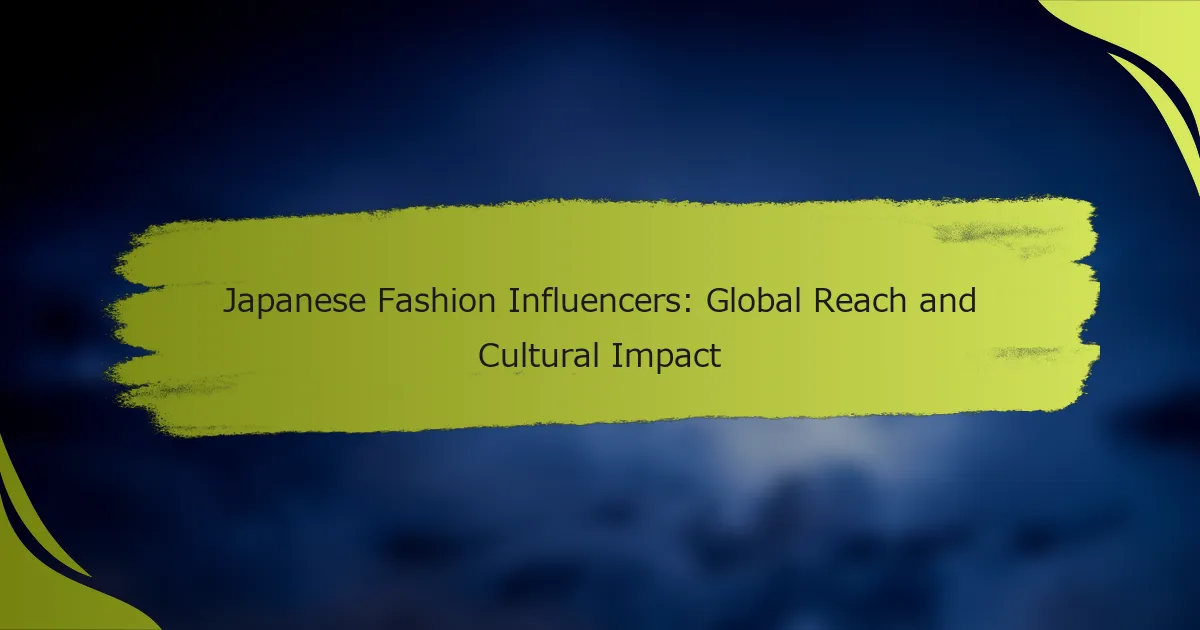日本のファッションインフルエンサーは、伝統的な美学と現代的なスタイルを融合させることで、世界的なトレンドに大きな影響を与えています。彼らのユニークなファッションステートメントは、ストリートウェアやラグジュアリーマーケットにおいても強い影響力を持ち、ソーシャルメディアを通じてグローバルなオーディエンスとつながっています。

How do Japanese fashion influencers shape global trends?
Japanese fashion influencers significantly shape global trends by blending traditional aesthetics with modern styles, creating unique fashion statements that resonate worldwide. Their ability to merge cultural elements with contemporary fashion has led to a strong influence on both streetwear and luxury markets.
Influencer collaborations with international brands
Collaborations between Japanese fashion influencers and international brands often result in innovative collections that attract global attention. These partnerships leverage the influencer’s unique style and cultural background, appealing to diverse audiences and enhancing brand visibility.
For instance, collaborations with well-known brands like Uniqlo or Comme des Garçons showcase how influencers can drive sales and engagement through their distinct fashion perspectives. Such partnerships not only elevate the influencer’s status but also introduce the brand to new consumer segments.
Impact on streetwear and luxury fashion
Japanese fashion influencers have a profound impact on both streetwear and luxury fashion, often setting trends that are quickly adopted worldwide. Their unique styles, characterized by bold colors, layering, and avant-garde designs, inspire global fashion enthusiasts and designers alike.
Streetwear brands frequently draw inspiration from Japanese aesthetics, leading to a fusion of styles that resonate with younger consumers. Meanwhile, luxury brands are increasingly incorporating elements from Japanese fashion, recognizing the market’s demand for innovative and culturally rich designs.
Social media platforms driving influence
Social media platforms like Instagram, TikTok, and Twitter are crucial for Japanese fashion influencers in shaping global trends. These platforms allow influencers to showcase their styles, engage with followers, and collaborate with brands, amplifying their reach and impact.
On Instagram, for example, influencers can create visually appealing content that highlights their fashion choices, while TikTok’s short-form videos enable them to share styling tips and trends rapidly. This dynamic presence on social media not only influences consumer behavior but also encourages brands to adapt to the evolving fashion landscape.
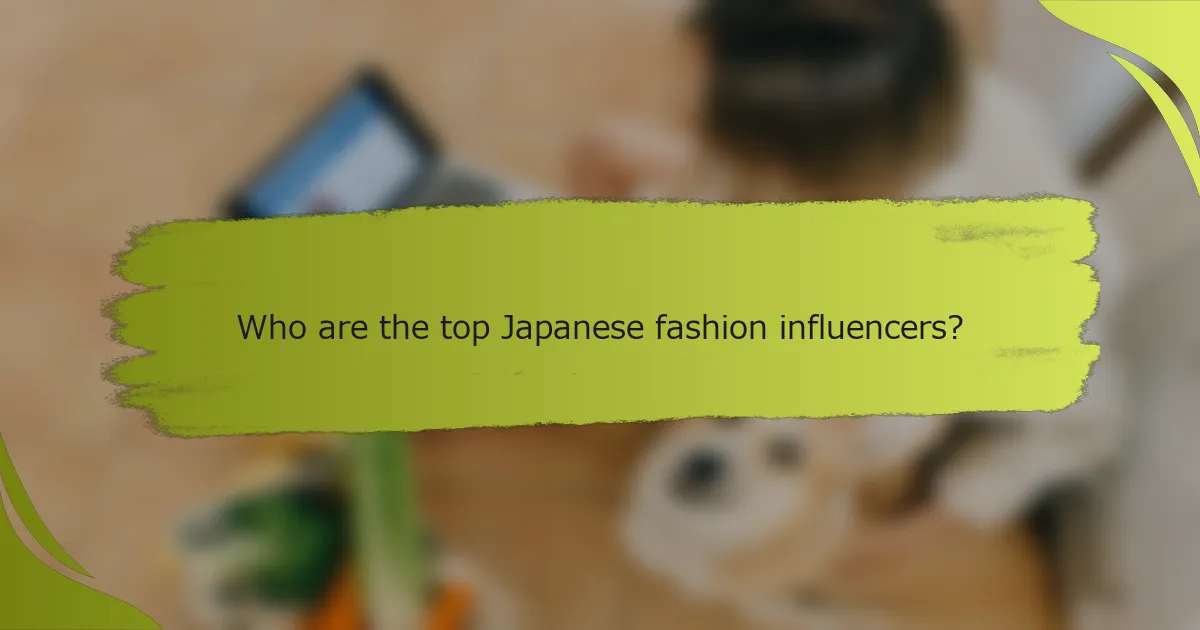
Who are the top Japanese fashion influencers?
The top Japanese fashion influencers are individuals who have significantly shaped global fashion trends through their unique styles and strong online presence. They leverage social media platforms to connect with audiences worldwide, showcasing a blend of traditional Japanese aesthetics and contemporary fashion.
Rina Sawayama
Rina Sawayama is a multifaceted artist known for her innovative approach to fashion and music. Her style often combines elements of Japanese culture with Western pop influences, making her a standout figure in the fashion world.
She frequently collaborates with renowned designers and uses her platform to challenge norms, promoting inclusivity and diversity in fashion. Sawayama’s bold choices and vibrant aesthetics resonate with a global audience, establishing her as a significant influencer.
Yoyo Cao
Yoyo Cao is a prominent fashion influencer and designer based in Singapore, originally from Japan. She is celebrated for her chic, minimalist style that often incorporates high-end streetwear and luxury brands.
Cao shares her fashion insights through her social media channels, where she engages with her followers by showcasing her outfits and providing styling tips. Her influence extends beyond fashion, as she often highlights sustainable practices in the industry.
Masaki Matsumoto
Masaki Matsumoto is a rising star in the Japanese fashion scene, known for his avant-garde designs and unique styling. His work often reflects a deep appreciation for traditional Japanese craftsmanship while pushing the boundaries of contemporary fashion.
Matsumoto uses his influence to promote local artisans and sustainable fashion practices, encouraging a return to craftsmanship in a fast-paced industry. His innovative designs and commitment to cultural heritage make him a key figure among Japanese fashion influencers.
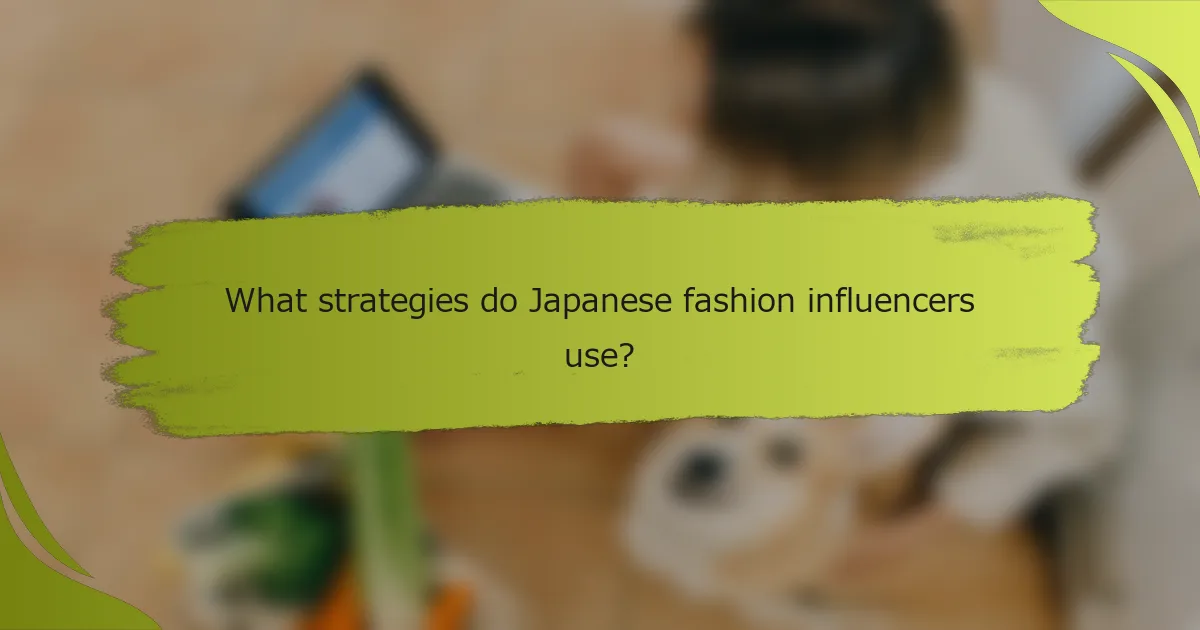
What strategies do Japanese fashion influencers use?
Japanese fashion influencers employ a variety of strategies to connect with their audience and expand their global reach. These methods include engaging storytelling, effective use of social media platforms, and strong personal branding.
Engaging storytelling through visuals
Visual storytelling is a powerful tool for Japanese fashion influencers, allowing them to convey their unique style and cultural narratives. By using high-quality images and videos, they create a vivid representation of their fashion choices that resonates with followers.
Incorporating elements of Japanese culture, such as traditional patterns or contemporary street style, helps to establish a deeper connection with their audience. This approach not only showcases their fashion sense but also tells a story that reflects their identity and heritage.
Utilizing Instagram and TikTok effectively
Instagram and TikTok are essential platforms for Japanese fashion influencers, offering dynamic ways to engage with their audience. On Instagram, influencers often share curated feeds that highlight their outfits, while TikTok allows for creative short videos that can go viral quickly.
To maximize their impact, influencers should post regularly and use trending hashtags to increase visibility. Engaging with followers through comments and direct messages also fosters a sense of community, encouraging loyalty and interaction.
Building personal brands
Establishing a personal brand is crucial for Japanese fashion influencers aiming for long-term success. This involves creating a consistent aesthetic and voice across all platforms, which helps followers recognize and connect with them.
Influencers can enhance their personal brand by collaborating with fashion brands, participating in events, and sharing their fashion journey. Authenticity is key; influencers should remain true to their style and values to build trust with their audience.
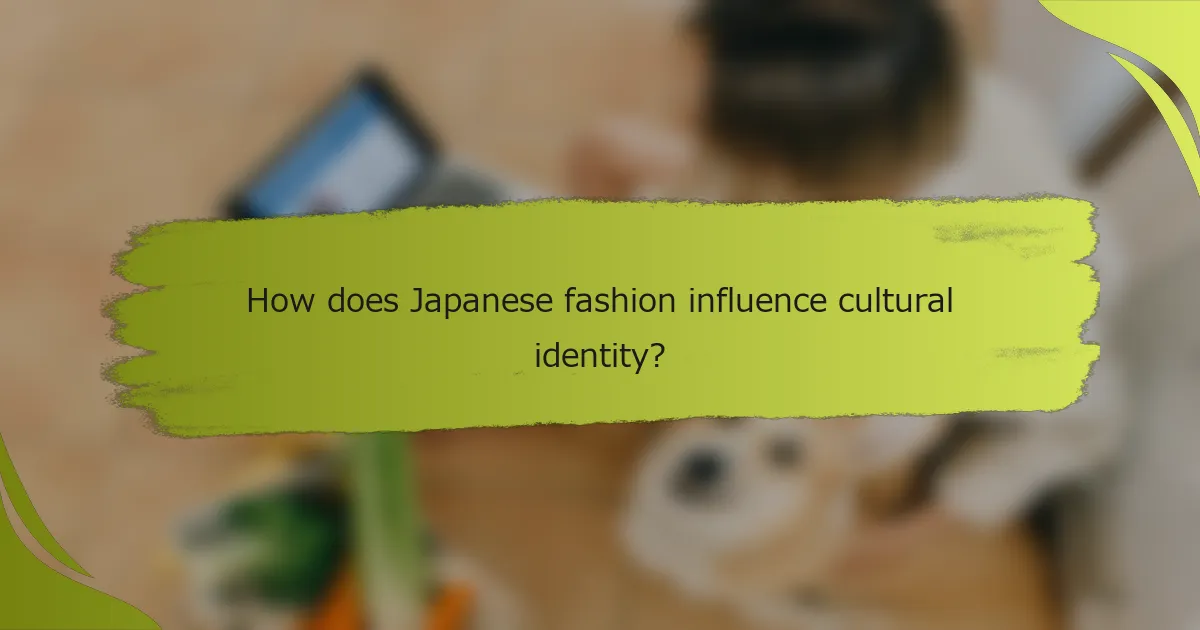
How does Japanese fashion influence cultural identity?
Japanese fashion significantly shapes cultural identity by blending traditional elements with contemporary trends, creating a unique expression of heritage and modernity. This influence is evident in various fashion styles that reflect Japan’s rich history while appealing to global audiences.
Representation of traditional Japanese aesthetics
Traditional Japanese aesthetics are often characterized by simplicity, natural materials, and a deep appreciation for craftsmanship. Styles such as kimono and yukata showcase intricate patterns and colors that convey cultural narratives and seasonal changes.
These garments are not just clothing; they symbolize cultural pride and identity. Events like festivals and ceremonies often see the wearing of traditional attire, reinforcing community bonds and cultural heritage.
Fusion of modern and traditional styles
The fusion of modern and traditional styles in Japanese fashion creates innovative looks that resonate with both local and international audiences. Designers frequently incorporate traditional motifs into contemporary clothing, resulting in unique pieces that honor heritage while appealing to modern tastes.
Street fashion in areas like Harajuku exemplifies this blend, where individuals mix vintage kimonos with modern accessories, creating a vibrant and eclectic style. This approach not only showcases creativity but also promotes cultural exchange and appreciation globally.

What are the challenges faced by Japanese fashion influencers?
Japanese fashion influencers encounter several challenges, including navigating cultural appropriation debates and balancing authenticity with commercial partnerships. These issues can impact their credibility and the perception of their work both locally and globally.
Navigating cultural appropriation debates
Cultural appropriation remains a significant concern for Japanese fashion influencers, as they often draw inspiration from various cultures. This can lead to accusations of insensitivity if cultural elements are used without proper context or respect.
To address these debates, influencers should engage in thorough research and seek to understand the cultural significance of the styles they promote. Collaborating with individuals from the cultures they reference can also foster a more respectful and informed approach.
Balancing authenticity with commercial partnerships
Japanese fashion influencers frequently face the challenge of maintaining their authentic voice while pursuing commercial partnerships. Brands often seek influencers to promote products, which can sometimes conflict with the influencer’s personal style or values.
To strike a balance, influencers should carefully select partnerships that align with their brand and resonate with their audience. Transparency about sponsored content is crucial to maintain trust and authenticity with followers.

How do Japanese fashion influencers engage with local audiences?
Japanese fashion influencers connect with local audiences through interactive experiences and collaborations that resonate culturally. By leveraging social media and in-person events, they create a strong community around fashion trends and local styles.
Hosting events and pop-up shops in Tokyo
Influencers often host events and pop-up shops in Tokyo to directly engage with their followers. These events provide a platform for fans to meet influencers, try on clothing, and purchase exclusive items. Locations in trendy districts like Shibuya and Harajuku are popular for attracting large crowds.
During these events, influencers may also incorporate live demonstrations or styling sessions, enhancing the experience. This personal interaction fosters a sense of community and loyalty among attendees.
Collaborating with local designers
Collaboration with local designers is a key strategy for Japanese fashion influencers to strengthen their ties with the community. By showcasing unique pieces from emerging designers, influencers not only promote local talent but also curate a distinct fashion narrative that appeals to their audience.
These partnerships often lead to limited-edition collections that create buzz and urgency among followers. Influencers can leverage their platforms to highlight the stories behind the designs, making the collaborations more meaningful and engaging.
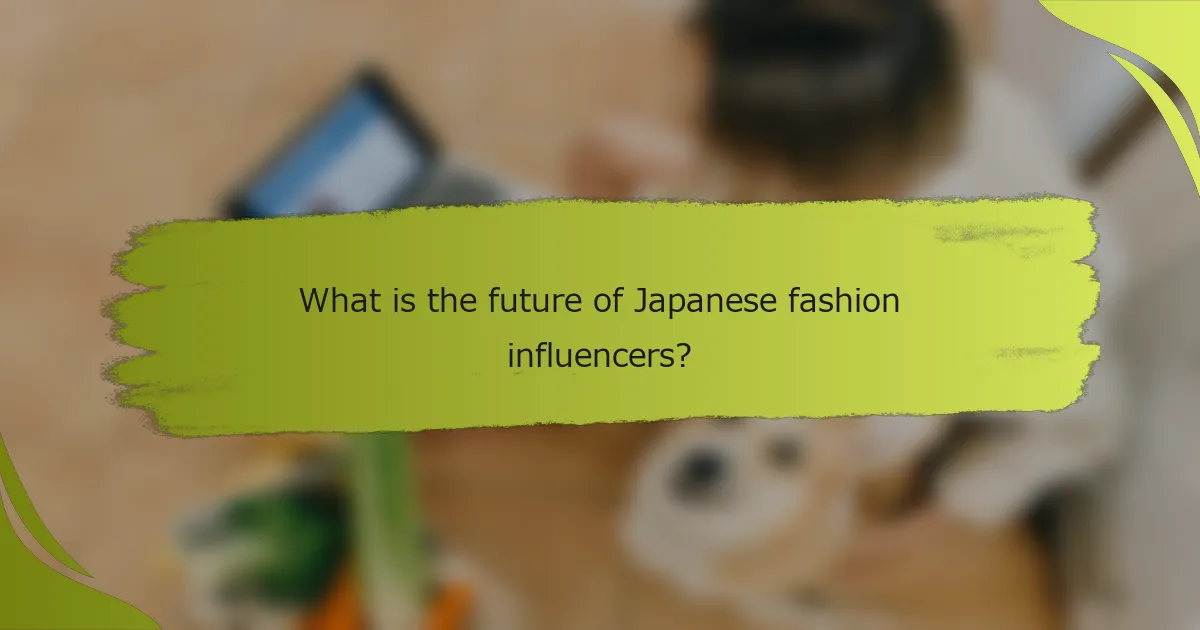
What is the future of Japanese fashion influencers?
The future of Japanese fashion influencers looks promising, driven by their unique blend of cultural authenticity and global appeal. As they continue to shape trends and engage audiences worldwide, their influence is expected to grow, particularly through digital platforms.
Emerging trends in digital fashion
Digital fashion is rapidly evolving, with Japanese influencers at the forefront of this transformation. They are leveraging augmented reality (AR) and virtual reality (VR) to create immersive experiences that allow consumers to engage with fashion in new ways.
Additionally, the rise of non-fungible tokens (NFTs) is creating opportunities for influencers to monetize their digital designs and collaborations. This trend not only enhances brand visibility but also allows fans to own unique pieces of digital art.
To stay relevant, influencers should focus on building strong online communities and engaging with their followers through interactive content. This can include live-streamed fashion shows, behind-the-scenes looks at their creative processes, and collaborations with other creators to broaden their reach.
